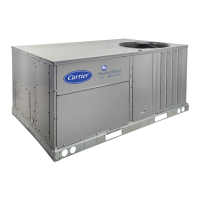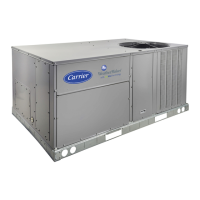183
APPENDIX C — VFD INFORMATION (cont)
CORRECTING ALARMS
To correct alarms, first determine if the Alarm requires any
corrective action (action is not always required). Use Table D
to find and address the root cause of the problem.
If diagnostics troubleshooting has determined that the drive is
defective during the warranty period, contact ABB Automation
Inc., at 1-800-435-7365, option 4, option 3. A qualified techni-
cian will review the problem with the caller and make a deter-
mination regarding how to proceed. This may involve dis-
patching a designated service station (DSS) representative
from an authorized station, dispatching a replacement unit, or
advising return for repair.
VFD Maintenance
If installed in an appropriate environment, the VFD requires
very little maintenance.
Table E lists the routine maintenance intervals recommended
by Carrier.
HEAT SINK
The heat sink fins accumulate dust from the cooling air. Since a
dusty sink is less efficient at cooling the drive, overtemperature
faults become more likely. In a normal environment check the heat
sink annually, in a dusty environment check more often.
Check the heat sink as follows (when necessary):
1. Remove power from drive.
2. Remove the cooling fan.
3. Blow clean compressed air (not humid) from bottom to top
and simultaneously use a vacuum cleaner at the air outlet to
trap the dust. If there a risk of the dust entering adjoining
equipment, perform the cleaning in another room.
4. Replace the cooling fan.
5. Restore power.
Table D — Alarm Codes
* This alarm is not indicated by a relay output, even when the relay out-
put is configured to indicate alarm conditions, parameter 1401 RE-
LAY OUTPUT = 5 (ALARM) or 16 (FLT/ALARM).
ALARM
CODE
ALARM NAME
IN PANEL
DESCRIPTION AND RECOMMENDED CORRECTIVE ACTION
2001 —
Reserved
2002 —
Reserved
2003 —
Reserved
2004 DIR LOCK
The change in direction being attempted is not allowed. Do not attempt to change the direction of motor rotation,
or Change parameter 1003 DIRECTION to allow direction change (if reverse operation is safe).
2005 I/O COMM
Field bus communication has timed out. Check fault setup (3018 COMM FAULT FUNC and 3019 COMM FAULT
TIME). Check communication settings (Group 51 or 53 as appropriate). Check for poor connections and/or noise
on line.
2006 AI1 LOSS
Analog input 1 is lost, or value is less than the minimum setting. Check input source and connections. Check the
parameter that sets the minimum (3021) and the parameter that sets the Alarm/Fault operation (3001).
2007 AI2 LOSS
Analog input 2 is lost, or value is less than the minimum setting. Check input source and connections. Check
parameter that sets the minimum (3022) and the parameter that sets the Alarm/Fault operation (3001).
2008 PANEL LOSS
Panel communication is lost and either the VFD is in local control mode (the control panel displays HAND), or the
VFD is in remote control mode (AUTO) and is parameterized to accept start/stop, direction or reference from the
control panel. To correct, check the communication lines and connections, Parameter 3002 PANEL LOSS, and
parameters in groups 10 COMMAND INPUTS and 11 REFERENCE SELECT (if drive operation is REM).
2009 —
Reserved
2010 MOT OVERTEMP
Motor is hot, based on either the VFD estimate or on temperature feedback. This alarm warns that a Motor Over-
load fault trip may be near. Check for overloaded motor. Adjust the parameters used for the estimate (3005
through 3009). Check the temperature sensors and Group 35 parameters.
2011 UNDERLOAD
Motor load is lower than expected. This alarm warns that a Motor Underload fault trip may be near. Check that the
motor and drive ratings match (motor is NOT undersized for the drive). Check the settings on parameters 3013 to
3015.
2012 MOTOR STALL
Motor is operating in the stall region. This alarm warns that a Motor Stall fault trip may be near.
2013* AUTORESET
This alarm warns that the drive is about to perform an automatic fault reset, which may start the motor. To control
automatic reset, use parameter group 31 (AUTOMATIC RESET).
2014* AUTOCHANGE
This alarm warns that the PFA autochange function is active. To control PFA, use parameter group 81 (PFA) and
the Pump Alternation macro.
2015 PFA INTERLOCK
This alarm warns that the PFA interlocks are active, which means that the drive cannot start any motor (when
Autochange is used), or a speed regulated motor (when Autochange is not used).
2016 — Reserved
2017* OFF BUTTON This alarm indicates that the OFF button has been pressed.
2018*
PID SLEEP
This alarm warns that the PID sleep function is active, which means that the motor could accelerate when the PID
sleep function ends. To control PID sleep, use parameters 4022 through 4026 or 4122 through 4126.
2019 ID RUN The VFD is performing an ID run.
2020 OVERRIDE Override mode is activated.
2021
START ENABLE 1
MISSING
This alarm warns that the Start Enable 1 signal is missing. To control Start Enable 1 function, use parameter
1608. To correct, check the digital input configuration and the communication settings.
2022
START ENABLE 2
MISSING
This alarm warns that the Start Enable 2 signal is missing. To control Start Enable 2 function, use parameter
1609. To correct, check the digital input configuration and the communication settings.
2023 EMERGENCY STOP Emergency stop is activated.

